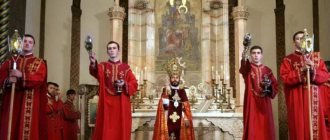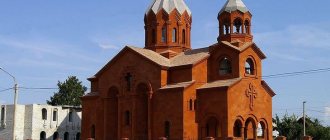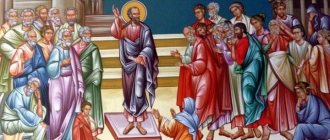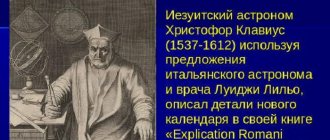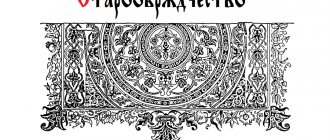Old Believers today
In recent years, an increasing number of our fellow citizens have become interested in issues of a healthy lifestyle, environmentally friendly farming methods, survival in extreme conditions, the ability to live in harmony with nature, and spiritual improvement. In this regard, many turn to the thousand-year experience of our ancestors, who managed to develop the vast territories of present-day Russia and created agricultural, trade and military outposts in all remote corners of our Motherland.
Last but not least, in this case we are talking about the Old Believers - people who at one time settled not only the territories of the Russian Empire, but also brought the Russian language, Russian culture and Russian faith to the banks of the Nile, to the jungles of Bolivia, the wastelands of Australia and to the snow-capped hills of Alaska . The experience of the Old Believers is truly unique : they were able to preserve their religious and cultural identity in the most difficult natural and political conditions and not lose their language and customs. It is no coincidence that the famous hermit Agafya Lykova from the Lykov family of Old Believers is so well known all over the world.
not much is known about the Old Believers Some people believe that Old Believers are people with a primitive education who adhere to outdated farming methods. Others think that Old Believers are people who profess paganism and worship the ancient Russian gods - Perun, Veles, Dazhdbog and others. Still others ask the question: if there are Old Believers, then there must be some kind of old faith? Read the answer to these and other questions regarding Old Believers in our article.
Old and new faith
One of the most tragic events in the history of Russia in the 17th century was the schism of the Russian Church . Tsar Alexei Mikhailovich Romanov and his closest spiritual associate, Patriarch Nikon (Minin), decided to carry out a global church reform. Having begun with seemingly insignificant changes - a change in the folding of fingers during the sign of the cross from two to three fingers and the abolition of prostrations, the reform soon affected all aspects of the Divine Service and the Rule. Continuing and developing to one degree or another until the reign of Emperor Peter I , this reform changed many canonical rules, spiritual institutions, customs of church administration, written and unwritten traditions. Almost all aspects of the religious, and then cultural and everyday life of the Russian people underwent changes.
Painting by V. G. Perov “Nikita Pustosvyat. Dispute about faith"
However, with the beginning of the reforms, it became clear that a significant number of Russian Christians saw in them an attempt to betray the doctrine itself, to destroy the religious and cultural structure that had developed for centuries in Rus' after its Baptism. Many priests, monks and laity spoke out against the plans of the tsar and the patriarch. They wrote petitions, letters and appeals, denouncing innovations and defending the faith that had been preserved for hundreds of years. In their writings, apologists pointed out that the reforms not only forcibly reshape traditions and legends, under pain of execution and persecution, but also affected the most important thing - they destroyed and changed the Christian faith itself. Almost all defenders of the ancient church tradition wrote that Nikon’s reform was apostate and changed the faith itself. Thus, the holy martyr Archpriest Avvakum pointed out:
They lost their way and retreated from the true faith with Nikon, an apostate, a malicious, pernicious heretic. They want to establish faith with fire, the whip, and the gallows!
He also called not to be afraid of torturers and to suffer for the “ old Christian Faith .” Spiridon Potemkin , expressed himself in the same spirit :
Trying to scrutinize the true faith will be damaged by heretical pretexts (additions), so that faithful Christians will not understand, but may be seduced into deception.
Potemkin condemned the Divine services and rituals performed according to the new books and new orders, which he called “evil faith”:
Heretics are those who baptize into their evil faith; they baptize blaspheming God into the One Holy Trinity.
The confessor and martyr Deacon Theodore wrote about the need to defend the fatherly tradition and the old Russian faith, citing numerous examples from the history of the Church:
The heretic starved the pious people who suffered from him for the old faith in exile... And if God vindicates the old faith as a single priest before the whole kingdom, all the authorities will be disgraced and reproached by the whole world.
The monastic confessors of the Solovetsky Monastery, who refused to accept the reform of Patriarch Nikon, wrote to Tsar Alexei Mikhailovich in their fourth petition:
Commanded, sir, that we should be in our same Old Faith, in which your father the sovereign and all the noble kings and great princes and our fathers died, and the venerable fathers Zosima and Savatius, and Herman, and Metropolitan Philip and all the holy fathers pleased God.
So gradually it began to be said that before the reforms of Patriarch Nikon and Tsar Alexei Mikhailovich, before the church schism, there was one faith, and after the schism there was another faith. The pre-schism confession began to be called the old faith , and the post-schism reformed confession - the new faith .
This opinion was not denied by the supporters of Patriarch Nikon’s reforms themselves. Thus, Patriarch Joachim, at a famous debate in the Faceted Chamber, said:
First a new faith was established; with the advice and blessing of the most holy ecumenical patriarchs.
While still an archimandrite, he stated:
I don’t know either the old faith or the new faith, but I do whatever the leaders tell me to do.
old faith gradually appeared , and people professing it began to be called “Old Believers”, “Old Believers”. Thus, Old Believers began to be called people who refused to accept the church reforms of Patriarch Nikon and adhered to the church institutions of ancient Russia, that is, the old faith . Those who accepted the reform began to be called “new believers” or “ new lovers .” However, the term “ New Believers” did not take root for long, and the term “Old Believers” still exists today.
Old Believers or Old Believers?
For a long time, in government and church documents, Orthodox Christians who preserved ancient liturgical rites, early printed books and customs were called “ schismatics .” They were accused of being faithful to church tradition, which allegedly led to a church schism. For many years, schismatics were subjected to repression, persecution, and infringement of civil rights.
However, during the reign of Catherine the Great, attitudes towards the Old Believers began to change. The Empress believed that the Old Believers could be very useful for settling the uninhabited areas of the expanding Russian Empire.
At the suggestion of Prince Potemkin, Catherine signed a number of documents granting them rights and benefits to live in special areas of the country. In these documents, the Old Believers were named not as “schismatics,” but as “Old Believers,” which, if not a sign of goodwill, undoubtedly indicated a weakening of the state’s negative attitude toward the Old Believers. Old Orthodox Christians, Old Believers , however, did not suddenly agree to the use of this name. In apologetic literature and the resolutions of some Councils it was indicated that the term “Old Believers” was not entirely acceptable.
It was written that the name “Old Believers” implies that the reasons for the church division of the 17th century lay in the same church rituals, while the faith itself remained completely intact. Thus, the Irgiz Old Believer Council of 1805 called co-religionists “Old Believers,” that is, Christians who use old rituals and old printed books, but obey the Synodal Church. The resolution of the Irgiz Cathedral read:
Others retreated from us to the renegades, called Old Believers, who, like us, keep old printed books and conduct services from them, but have no shame in communicating with everyone in everything, both in prayer and in eating and drinking.
In the historical and apologetic writings of the Old Orthodox Christians of the 18th - first half of the 19th centuries, the terms “Old Believers” and “Old Believers” continued to be used. They are used, for example, in the “History of the Vygovskaya Hermitage” by Ivan Filippov, the apologetic work “Deacon’s Answers” and others. This term was also used by numerous New Believer authors, such as N.I. Kostomarov, S. Knyazkov. P. Znamensky, for example, in the 1870 edition of the “Guide to Russian History” says:
Peter became much stricter towards the Old Believers.
At the same time, over the years, some Old Believers began to use the term “ Old Believers .” Moreover, as the famous Old Believers writer Pavel the Curious (1772–1848) points out in his historical dictionary, the name Old Believers is more characteristic of non-priestly concords, and “Old Believers” - to persons belonging to concords that accept the fleeing priesthood.
And indeed, by the beginning of the 20th century, the agreements that accepted the priesthood (Belokrinitsky and Beglopopovsky) began to increasingly use Old Believers , Old Believers ” . Soon the name Old Believers was enshrined at the legislative level by the famous decree of Emperor Nicholas II “On strengthening the principles of religious tolerance.” The seventh paragraph of this document reads:
To assign the name Old Believers , instead of the currently used name of schismatics, to all followers of rumors and agreements who accept the basic dogmas of the Orthodox Church, but do not recognize some of the rituals accepted by it and conduct their worship according to old printed books.
However, even after this, many Old Believers continued to be called Old Believers . The non-priest consents especially carefully preserved this name. D. Mikhailov, author of the magazine “Native Antiquity”, published by the Old Believer circle of adherents of Russian antiquity in Riga (1927), wrote:
Archpriest Avvakum speaks about the “old Christian faith,” and not about “rites.” Old Believer” found anywhere .
Changing attitudes towards the term “Old Believers” in society
However, by the end of the 19th century, the situation in society and the Russian Empire began to change. The government began to pay great attention to the needs and demands of the Old Orthodox Christians; a certain generalizing term was needed for civilized dialogue, regulations and legislation.
For this reason, the terms “ Old Believers ” and “Old Believers” are becoming increasingly widespread. At the same time, Old Believers of different consents mutually denied each other’s Orthodoxy and, strictly speaking, for them the term “Old Believers” united, on a secondary ritual basis, religious communities deprived of church-religious unity. For the Old Believers, the internal inconsistency of this term consisted in the fact that, using it, they united in one concept the truly Orthodox Church (i.e., their own Old Believer consent) with heretics (i.e., Old Believers of other consents).
Nevertheless, the Old Believers at the beginning of the 20th century positively perceived that in the official press the terms “schismatics” and “schismatic” began to be gradually replaced by “Old Believers” and “Old Believer.” The new terminology did not have a negative connotation, and therefore the Old Believer consents began to actively use it in the social and public sphere.
The word “Old Believers” is accepted not only by believers. Secular and Old Believer publicists and writers, public and government figures are increasingly using it in literature and official documents. At the same time, conservative representatives of the Synodal Church in pre-revolutionary times continue to insist that the term “Old Believers” is incorrect.
“Recognizing the existence of the “ Old Believers ,” they said, “we will have to admit the presence of the “ New Believers ,” that is, admit that the official church uses not ancient, but newly invented rites and rituals.”
According to the New Believer missionaries, such self-exposure could not be allowed.
And yet, over time, the words “Old Believers” and “Old Believers” became more and more firmly rooted in literature and in everyday speech, displacing the term “schismatics” from the colloquial use of the overwhelming majority of supporters of “official” Orthodoxy.
What do Old Believers believe?
The Old Believers, as the heirs of pre-schism, pre-reform Russia, try to preserve all the dogmas, canonical provisions, ranks and followers of the Old Russian Church.
First of all, of course, this concerns the main church dogmas: the confession of St. Trinity, the incarnation of God the Word, two hypostases of Jesus Christ, his atoning Sacrifice on the Cross and Resurrection. The main difference between the confession of the Old Believers and other Christian confessions is the use of forms of worship and church piety characteristic of the ancient Church.
Among them are the two-fingered sign of the cross, immersion baptism, unison singing, canonical iconography, and special prayer clothing. For Divine services, the Old Believers use old printed liturgical books published before 1652 (mainly published under the last pious Patriarch Joseph. The Old Believers , however, do not represent a single community or church - for hundreds of years they were divided into two main directions: priests and non-priests.
Old Believers—Priests
The Old Believers - priests, in addition to other church institutions, recognize the three-tier Old Believer hierarchy (priesthood) and all the church sacraments of the ancient Church, among which the most famous are: Baptism, Confirmation, Eucharist, Priesthood, Marriage, Confession (Repentance), Blessing of Anointing. In addition to these seven sacraments in the Old Belief , there are other, somewhat less known sacraments and sacred rites, namely: tonsure as a monk (equivalent to the sacrament of Marriage), the Great and Small Blessing of Water, the Blessing of Oil on Polyeleos, and the priestly blessing.
Old Believers without priests
Old Believers without priests believe that after the church schism caused by Tsar Alexei Mikhailovich, the pious church hierarchy (bishops, priests, deacons) disappeared. Therefore, some of the church sacraments in the form in which they existed before the schism of the Church were abolished. Today, all Old Believers without priests definitely recognize only two sacraments: Baptism and Confession (repentance). Some non-priests (Old Orthodox Pomeranian Church) also recognize the sacrament of Marriage. The Old Believers of the Chapel Concord also allow the Eucharist (Communion) with the help of St. gifts consecrated in ancient times and preserved to this day. Also, the chapels recognize the Great Blessing of water, which on the day of Epiphany is received by pouring into new water water that was blessed in the old days, when, in their opinion, there were still pious priests.
Old Believer teachers, synodal theologians and secular scholars about the term “Old Believers”
Reflecting on the concept of “Old Believers,” writers, theologians and publicists gave different assessments. Until now, the authors cannot come to a common opinion.
It is no coincidence that even in the popular book, the dictionary “Old Believers. Persons, objects, events and symbols” (M., 1996), published by the publishing house of the Russian Orthodox Old Believer Church, there is no separate article “Old Believers” that would explain the essence of this phenomenon in Russian history. The only thing here is that it is only noted that this is “a complex phenomenon that unites under one name both the true Church of Christ and the darkness of error.”
The perception of the term “Old Believers” is noticeably complicated by the presence among Old Believers of divisions into “concords” (Old Believer churches), which are divided into supporters of a hierarchical structure with Old Believer priests and bishops (hence the name: priests - Russian Orthodox Old Believer Church , Russian Old Orthodox Church ) and into those who do not accept priests and bishops - non-priests ( Ancient Orthodox Pomeranian Church , Chapel Concord , runners (wanderer consent), Fedoseyevskoe consent).
Old Believers or Old Believers?
From time to time, a discussion arises among Old Believers of all agreements: “ Can they be called Old Believers ?” Some argue that it is necessary to call ourselves exclusively Christians because no old faith and old rituals exist, as well as a new faith and new rituals. According to such people, there is only one true, one right faith and only true Orthodox rituals, and everything else is heretical, non-Orthodox, crooked Orthodox confession and wisdom.
Others, as mentioned above, consider it absolutely obligatory to be called Old Believers, professing the old faith, because they believe that the difference between the Old Orthodox Christians and the followers of Patriarch Nikon is not only in rituals, but also in the faith itself.
Still others believe that the word Old Believers should be replaced with the term “ Old Believers .” In their opinion, there is no difference in faith between the Old Believers and the followers of Patriarch Nikon (Nikonians). The only difference is in the rituals, which among the Old Believers are correct, while among the Nikonians they are damaged or completely incorrect.
There is a fourth opinion regarding the concept of Old Believers and the old faith. It is shared mainly by the children of the Synodal Church. In their opinion, between the Old Believers (Old Believers) and the New Believers (New Believers) there is not only a difference in faith, but also in rituals. They call both old and new rituals equally honorable and equally salutary. The use of one or another is only a matter of taste and historical and cultural tradition. This is stated in the resolution of the Local Council of the Moscow Patriarchate of 1971.
Currents and types of Old Believers
Considering the regionality and distance from each other of those dissatisfied with the new rules of Nikon’s reform, several decades later different movements of Old Believers appeared. This is due to the fact that the clergy, who inspired the schismatics and gathered a large number of followers, not only sought to defend the principles of the Old Belief, but also to introduce their own ideas and beliefs.
Representatives of different agreements of the Old Believers did not recognize each other , considering their own faith and traditions to be true.
Popov's consent
The most popular movement of the Old Believers was “priesthood.” The Old Believers of this agreement existed and conducted their activities similarly to the Orthodox Church. They had their own priests, who were considered necessary for conducting rituals and sacraments. The stronghold of the priests-Old Believers was in the Nizhny Novgorod region, later it spread throughout Russia - to the Don region, Chernigov, and in the 19th century the main community was in Moscow.
The Old Believers accepted clergy from the Orthodox Church, since they themselves could not ordain clergy, and moreover, they believed that continuity was preserved, despite the reforms.
In 1846, the Belokrinitsky hierarchy arose, which to this day remains the leading movement in the Old Believers. Some of the schismatics went over to the priestless sect, not wanting to obey Metropolitan Ambrose of Bosnia, who converted from Orthodoxy to the Old Believers.
Edinoverie
Edinoverie, the so-called Orthodox Old Believers. In 1800, they came under the control of the Russian Orthodox Church, while preserving all the traditions of the Old Believers unchanged, since the Orthodox Metropolitan declared “points of unity of faith.”
Today, communities of the same faith continue to exist.
Bespopovsky sects
As the name suggests, this movement of the Old Believers carried out its activities without clergy. After the death of the priest, there was no one to replace him, and the Old Believers did not trust those who followed the new principles and traditions in Orthodoxy. Therefore, left without a priest, the Old Believers were forced to appoint a layman to this position. It was necessary to abandon elements that could only be conducted by the clergy, but in general, services continued to be held.
The widespread residence of bespopovsky sects refers to the northern regions of Russia (the most widespread are the Danilov Pomeranian and Fedoseyevskoe concord), Karelia, the Vyatka province, and the Nizhny Novgorod region, but as a phenomenon they were found everywhere.
Apart from the refusal to abandon the clergy, this movement has taken many forms. Some consenters completely abandoned the icons, considering them desecrated, and prayed looking strictly east, for which they made a hole in the wall of the house (from which they received the name “holes”). Others preferred to run and hide from the authorities, not to pay taxes and other duties (these were called runners or wanderers).
List of schismatics of the Danilovsky priestless sect of 1904, Vyatka province. Old Believers of Oryol district. Source GAKO

